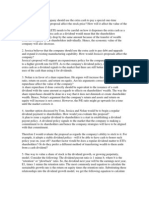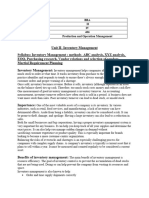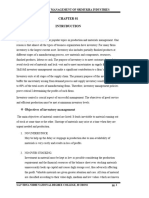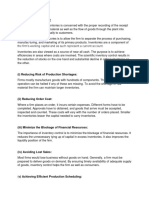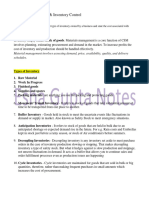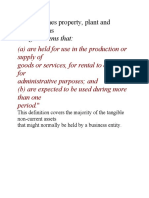Inventory Analysis-1
Inventory Analysis-1
Uploaded by
Md. Ramim RanaCopyright:
Available Formats
Inventory Analysis-1
Inventory Analysis-1
Uploaded by
Md. Ramim RanaCopyright
Available Formats
Share this document
Did you find this document useful?
Is this content inappropriate?
Copyright:
Available Formats
Inventory Analysis-1
Inventory Analysis-1
Uploaded by
Md. Ramim RanaCopyright:
Available Formats
Inventory Analysis
Using Inventory Analysis to
Streamline Operations
By Nada Nasri
Copyright © 2024 Nada Nasri. All rights reserved. www.linkedin.com/in/nada-nasri
What is Inventory Analysis?
Inventory Analysis
Inventory analysis involves evaluating stock levels to determine the ideal amount a business
should maintain. This process helps identify the inventory needed to meet customer demand
while boosting sales and managing costs effectively, ensuring profitability and efficiency.
Inventory analysis involves evaluating
stock levels and their impact on a
business. It helps improve cash flow,
prevent stockouts, and enhance
operational efficiency. By providing
insights, inventory analysis allows
businesses to be proactive. For
instance, a contractor can ensure they
have enough materials for a new
project. Additionally, it identifies trends
and helps maintain the right product
mix to meet customer demand
effectively.
Copyright © 2024 Nada Nasri. All rights reserved. www.linkedin.com/in/nada-nasri
Inventory Analysis
What Are the Benefits of Inventory Analysis?
Regular inventory analysis is essential for maintaining effective inventory management and
improving business efficiency. Here are key benefits:
1.Reduce Stockouts and Project Delays
Inventory analysis minimizes stockouts, preventing delays in projects that rely on numerous
materials. For retailers, it avoids lost sales and keeps customers from turning to competitors for
alternatives.
1.Improve Cash Flow
Poor cash flow causes 82% of business failures. Inventory analysis ensures cash isn’t tied up in
unsold stock or spent on emergency purchases of high-demand items. It helps balance
inventory levels, reduce losses from unsold goods, and prepare for seasonal fluctuations,
improving overall financial stability.
Copyright © 2024 Nada Nasri. All rights reserved. www.linkedin.com/in/nada-nasri
Inventory Analysis
What Are the Benefits of Inventory Analysis?
3. Delight Customers
Exceptional inventory analysis can enhance customer satisfaction. By leveraging robust inventory
systems, Amazon provides fast shipping, creating loyal customers. Similarly, accurate inventory
analysis enables businesses to fulfill orders promptly and build lasting customer relationships.
4. Reduce Inventory Waste
Inventory analysis helps eliminate excess stock and minimizes losses from theft, damage, or
obsolescence. By maintaining optimal stock levels, businesses avoid waste and improve cost
management, ensuring resources are allocated effectively.
5. Better Pricing from Suppliers
Understanding which products yield the highest profits empowers businesses to negotiate better
deals with suppliers. Streamlined inventory analysis identifies key products, enabling efficient supply
chains and improving profit margins.
Copyright © 2024 Nada Nasri. All rights reserved. www.linkedin.com/in/nada-nasri
How to Analyze Inventory
Inventory Analysis
ABC Analysis
ABC analysis is a widely used inventory management technique based on the Pareto Principle,
which asserts that 80% of outcomes come from 20% of inputs. In this context, the principle helps
prioritize inventory items by their impact on overall business performance.
The method categorizes inventory into three groups:
•A-Inventory:
High-value items with the greatest impact on profit margins or revenue. These require
meticulous management to avoid stockouts and should be a top priority.
•B-Inventory:
Mid-value items that sell consistently but generate less revenue than A-items. Managing these
involves balancing inventory holding costs with demand.
•C-Inventory:
Low-value items that contribute the least to revenue but often occupy the most storage space.
These should be monitored closely to avoid excess stock and reduce carrying costs.
5
Copyright © 2024 Nada Nasri. All rights reserved. www.linkedin.com/in/nada-nasri
How to Analyze Inventory
Inventory Analysis
Benefits of ABC Analysis
ABC analysis simplifies inventory management,
focusing attention on the most impactful products.
This helps businesses:
•Reduce obsolete inventory
•Improve inventory turnover rates
•Forecast demand more accurately
•Increase profitability
By leveraging ABC analysis, businesses can allocate
resources effectively and streamline their inventory
processes to maximize efficiency and revenue.
Copyright © 2024 Nada Nasri. All rights reserved. www.linkedin.com/in/nada-nasri
Inventory Analysis Methods
Inventory Analysis
1.VED Analysis
VED analysis evaluates inventory based on its criticality to operations:
1. Vital: Must always be in stock to avoid disruptions.
2. Essential: A minimal quantity is acceptable.
3. Desirable: Optional items that can be stocked sparingly.
This method is ideal for manufacturing businesses managing
numerous components and parts.
2. HML Analysis
Focuses solely on the unit price of items, disregarding sales value:
1. High Cost: Items with a high unit price.
2. Medium Cost: Moderately priced items.
3. Low Cost: Low-cost items.
HML analysis helps businesses control spending and maintain
budgets.
7
Copyright © 2024 Nada Nasri. All rights reserved. www.linkedin.com/in/nada-nasri
Inventory Analysis Methods
Inventory Analysis
3. SDE Analysis
Categorizes inventory by availability in the market:
Scarce: Rare or imported items with long lead times.
Difficult: Items with moderate lead times.
Easily Available: Readily obtainable items.
This method is crucial for businesses managing raw materials or dealing with supply chain complexities.
4. Safety Stock Analysis
Maintains extra inventory to prevent stockouts due to demand surges or supply disruptions.
Formula:
(Maximum Daily Usage × Maximum Lead Time ) – ( Average Daily Usage × Average Lead Time)
Safety stock acts as a buffer, ensuring consistent operations.
Copyright © 2024 Nada Nasri. All rights reserved. www.linkedin.com/in/nada-nasri
Key Metrics to Measure Inventory Efficiency
Inventory Analysis
1. Gross Margin Return on Invested Inventory (GMROI)
GMROI measures how much gross profit is earned for every dollar invested in inventory.
Formula:
Gross Profit Margin ÷ Average On−Hand Inventory Cost
•A GMROI above 1 indicates profitability.
•Example: A GMROI of 1.50 means you generate $1.50 for every $1 spent on inventory.
This metric helps retailers assess inventory profitability and identify underperforming stock.
2. Available to Promise (ATP)
ATP evaluates inventory availability for fulfilling customer orders, balancing supply and demand.
Formula:
ATP= Quantity On Hand + Supply (Planned Orders ) – Demand (Sales Orders)
• Ensures accurate order fulfillment and delivery estimates.
9
• Used in industries like retail and food delivery to optimize response times.
Copyright © 2024 Nada Nasri. All rights reserved. www.linkedin.com/in/nada-nasri
Inventory Analysis
Key Metrics to Measure Inventory Efficiency
3. Inventory Turnover Rate
This metric assesses how efficiently inventory is sold within a given period.
Formula:
Cost of Goods Sold (COGS) ÷ Average Inventory
•Example: If your average inventory is $1,000 and COGS is $10,000, your turnover rate is 10.
•A higher rate indicates faster inventory sales, reducing holding costs and avoiding overstock.
4. Carrying Costs (Holding Costs):
Carrying costs represent the expenses associated with storing and maintaining inventory,
such as insurance, warehouse rent, equipment maintenance, security, and labor. For
instance, owning a forklift to move stock in a warehouse is an example of a carrying cost.
These costs can be calculated separately or grouped as a total value, providing a clearer
picture of inventory-related expenditures.
10
Copyright © 2024 Nada Nasri. All rights reserved. www.linkedin.com/in/nada-nasri
Key Metrics to Measure Inventory Efficiency
Inventory Analysis
5. Average Days to Sell Inventory:
This metric tracks how long it takes for a company
to sell its inventory after purchasing or producing
it. It is calculated using the formula:
Average Days to Sell Inventory=Inventory Cost of Sales ×
Number of Days in the Year / Cost of Goods Sold (COGS)
This ratio helps businesses identify how efficiently
they turn over inventory, with a lower number
indicating faster sales.
11
Copyright © 2024 Nada Nasri. All rights reserved. www.linkedin.com/in/nada-nasri
Inventory Analysis
How to Analyze Inventory
6. Stockout Rate:
The stockout rate measures how often a business
runs out of inventory compared to total orders,
expressed as a percentage. For example, if a
clothing retailer generates $100,000 in total sales
but $10,000 of sales are back-ordered due to
stockouts, the stockout rate would be:
Stockout Rate=Back-Ordered Sales
Total Sales×100=10,000100,000×100=10 %
A high stockout rate may indicate poor inventory
planning, leading to missed opportunities and
dissatisfied customers. Reducing this rate,
particularly for high-demand items, can significantly
improve customer retention and profitability.
12
Copyright © 2024 Nada Nasri. All rights reserved. www.linkedin.com/in/nada-nasri
Inventory Analysis
How to Analyze Inventory
7. Customer Service Level (CSL):
CSL measures the probability of fulfilling customer demand without stockouts. Ideally, CSL should
approach 100%, especially for critical or high-demand inventory. A simple calculation for CSL is:
CSL=Number of Products Delivered On Time / Number of Products Sold×100
For example, if a business delivered 950 out of 1,000 orders on time, the CSL would be:
CSL=9501,000×100=95 %
This metric directly impacts customer satisfaction and loyalty, making it crucial for long-term
success.
13
Copyright © 2024 Nada Nasri. All rights reserved. www.linkedin.com/in/nada-nasri
Inventory Analysis
How to Start Using Inventory Analysis in Your Business
If you're new to inventory analysis, here are some essential steps to get started:
1.Audit Your Stock Levels
Before analyzing inventory, perform a thorough audit to ensure your physical stock matches your
records. Using a barcoding system can streamline this process, reducing errors and improving
accuracy.
2.Align Inventory Analysis with Your Strategy and Business Goals
There’s no universal approach to inventory analysis. Choose methods that suit your specific needs
and business goals. Whether you're aiming to reduce stockouts, improve cash flow, or optimize
turnover, make sure your analysis aligns with your broader strategy to allocate resources efficiently.
3.Use Inventory Management Software
Automating inventory management with software can save time and provide real-time tracking of
stock levels, sales, and reorder points. It helps ensure the right inventory is available when needed,
reducing the risk of overstocking or understocking.
14
Copyright © 2024 Nada Nasri. All rights reserved. www.linkedin.com/in/nada-nasri
Summary
To start using inventory analysis in your business, first, conduct a thorough audit of your stock
levels to ensure your physical inventory matches your records. Implementing a barcoding
system can improve the accuracy and efficiency of this process. Next, align your inventory
analysis with your business goals and strategy. There’s no one-size-fits-all method, so choose
techniques that best meet your specific needs, such as improving cash flow, reducing
stockouts, or optimizing turnover. By focusing on these objectives, you can ensure that your
inventory management is purposeful and efficient. Finally, leverage inventory management
software, to automate and streamline your processes. This software allows for real-time
tracking of stock, sales, and reorder points, ensuring the right inventory is available at the right
time. With these steps, you can improve decision-making and boost overall efficiency in your
inventory management.
I appreciate your time
15
Copyright © 2024 Nada Nasri. All rights reserved. www.linkedin.com/in/nada-nasri
You might also like
- Solution Manual, Managerial Accounting Hansen Mowen 8th Editions - CH 1389% (19)Solution Manual, Managerial Accounting Hansen Mowen 8th Editions - CH 1348 pages
- 9 Techniques For Effective Inventory ManagementNo ratings yet9 Techniques For Effective Inventory Management8 pages
- Inventory Managemen T: Name: Ajay Yadav Roll No: 04 Class: Mba B (Previous) Submitted To: Ms ShrutiNo ratings yetInventory Managemen T: Name: Ajay Yadav Roll No: 04 Class: Mba B (Previous) Submitted To: Ms Shruti44 pages
- Inventory Manangement - MONTES (AutoRecovered)No ratings yetInventory Manangement - MONTES (AutoRecovered)13 pages
- Inventory Is Considered To Be One of The Most Important Assets of A BusinessNo ratings yetInventory Is Considered To Be One of The Most Important Assets of A Business3 pages
- Book_PDF_Principles of Managerial Finance-GitmanNo ratings yetBook_PDF_Principles of Managerial Finance-Gitman5 pages
- Inventory Management Techniques and ItsNo ratings yetInventory Management Techniques and Its10 pages
- Inventory Management and JIT Group AssignmentNo ratings yetInventory Management and JIT Group Assignment24 pages
- Effective Inventory Management - Optimizing Business OperationsNo ratings yetEffective Inventory Management - Optimizing Business Operations24 pages
- End Term OF Strategic Cost Management: AssignmentNo ratings yetEnd Term OF Strategic Cost Management: Assignment13 pages
- Ijrpr2914 A Study of Inventory Management TechniqueNo ratings yetIjrpr2914 A Study of Inventory Management Technique3 pages
- Introduction To Inventory Management: Unit - 1No ratings yetIntroduction To Inventory Management: Unit - 152 pages
- E0036 Inventory Management at Hero Motocorp LTDNo ratings yetE0036 Inventory Management at Hero Motocorp LTD74 pages
- WP Your Complete Guide To Inventory ForecastingNo ratings yetWP Your Complete Guide To Inventory Forecasting16 pages
- DocInfo Using Inventory Optimization To Reduce Inventory Levels in A Lean EnvironmentNo ratings yetDocInfo Using Inventory Optimization To Reduce Inventory Levels in A Lean Environment16 pages
- Elegant & Minimalist Subtle Pastel Waves Portfolio by SlidesgoNo ratings yetElegant & Minimalist Subtle Pastel Waves Portfolio by Slidesgo33 pages
- The Seven Myths of Customer Management: How to be Customer-Driven Without Being Customer-LedFrom EverandThe Seven Myths of Customer Management: How to be Customer-Driven Without Being Customer-LedNo ratings yet
- STRATEGIC CASE STUDY PAPER 3.4 July 2024No ratings yetSTRATEGIC CASE STUDY PAPER 3.4 July 202435 pages
- Chapter 15 Afar Solman (Dayag 2015ed) - Prob 1 & 2No ratings yetChapter 15 Afar Solman (Dayag 2015ed) - Prob 1 & 21 page
- Operating Assets: Property, Plant, and Equipment, Natural Resources, and IntangiblesNo ratings yetOperating Assets: Property, Plant, and Equipment, Natural Resources, and Intangibles35 pages
- SID - Aditya Birla Sun Life Nifty India Defence Index FundNo ratings yetSID - Aditya Birla Sun Life Nifty India Defence Index Fund47 pages
- Babcock University Acct 434 Lecture 4 Double Taxation ReliefNo ratings yetBabcock University Acct 434 Lecture 4 Double Taxation Relief24 pages
- Aspects of Volatility Targeting For South AfricanNo ratings yetAspects of Volatility Targeting For South African9 pages
- FAC4861/ZFA4861/NFA4861: Tutorial Letter 103/0/2021100% (1)FAC4861/ZFA4861/NFA4861: Tutorial Letter 103/0/202185 pages
- Financial Planning and Forecasting: Dendry Baringin Ericson Diandra Renya Rosari Emba A 49 ANo ratings yetFinancial Planning and Forecasting: Dendry Baringin Ericson Diandra Renya Rosari Emba A 49 A12 pages
- Accountancy Unit Test 1 Paper Shalom 2ndNo ratings yetAccountancy Unit Test 1 Paper Shalom 2nd4 pages
- What Is Position Delta - Options Trading Concept Guide - ProjectoptionNo ratings yetWhat Is Position Delta - Options Trading Concept Guide - Projectoption9 pages
- Business Finance Introduction To Financial Management 02No ratings yetBusiness Finance Introduction To Financial Management 0219 pages
- Solution Manual, Managerial Accounting Hansen Mowen 8th Editions - CH 13Solution Manual, Managerial Accounting Hansen Mowen 8th Editions - CH 13
- Inventory Managemen T: Name: Ajay Yadav Roll No: 04 Class: Mba B (Previous) Submitted To: Ms ShrutiInventory Managemen T: Name: Ajay Yadav Roll No: 04 Class: Mba B (Previous) Submitted To: Ms Shruti
- Inventory Is Considered To Be One of The Most Important Assets of A BusinessInventory Is Considered To Be One of The Most Important Assets of A Business
- Effective Inventory Management - Optimizing Business OperationsEffective Inventory Management - Optimizing Business Operations
- Ijrpr2914 A Study of Inventory Management TechniqueIjrpr2914 A Study of Inventory Management Technique
- DocInfo Using Inventory Optimization To Reduce Inventory Levels in A Lean EnvironmentDocInfo Using Inventory Optimization To Reduce Inventory Levels in A Lean Environment
- Elegant & Minimalist Subtle Pastel Waves Portfolio by SlidesgoElegant & Minimalist Subtle Pastel Waves Portfolio by Slidesgo
- Learn Our Efficient Inventory Management TechniquesFrom EverandLearn Our Efficient Inventory Management Techniques
- The Seven Myths of Customer Management: How to be Customer-Driven Without Being Customer-LedFrom EverandThe Seven Myths of Customer Management: How to be Customer-Driven Without Being Customer-Led
- Chapter 15 Afar Solman (Dayag 2015ed) - Prob 1 & 2Chapter 15 Afar Solman (Dayag 2015ed) - Prob 1 & 2
- Operating Assets: Property, Plant, and Equipment, Natural Resources, and IntangiblesOperating Assets: Property, Plant, and Equipment, Natural Resources, and Intangibles
- SID - Aditya Birla Sun Life Nifty India Defence Index FundSID - Aditya Birla Sun Life Nifty India Defence Index Fund
- Babcock University Acct 434 Lecture 4 Double Taxation ReliefBabcock University Acct 434 Lecture 4 Double Taxation Relief
- FAC4861/ZFA4861/NFA4861: Tutorial Letter 103/0/2021FAC4861/ZFA4861/NFA4861: Tutorial Letter 103/0/2021
- Financial Planning and Forecasting: Dendry Baringin Ericson Diandra Renya Rosari Emba A 49 AFinancial Planning and Forecasting: Dendry Baringin Ericson Diandra Renya Rosari Emba A 49 A
- What Is Position Delta - Options Trading Concept Guide - ProjectoptionWhat Is Position Delta - Options Trading Concept Guide - Projectoption
- Business Finance Introduction To Financial Management 02Business Finance Introduction To Financial Management 02


